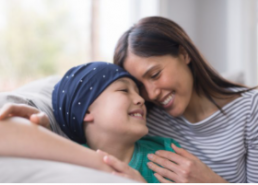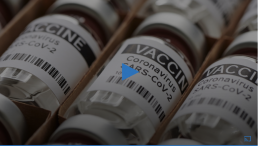Areas Patients with CLL Can Focus On to Maintain Their Health Beyond Treatment
Areas Patients with CLL Can Focus On to Maintain Their Health Beyond Treatment
This article was originally published on Cure
In a recent interview with CURE®, a medical oncologist from the Dana-Farber Cancer Institute discussed why it’s important for patients with CLL, regardless of their treatment plans, to keep up on vaccinations and maintain a regular cancer screening schedule.
Because patients with chronic lymphocytic leukemia (CLL) can sometimes be more susceptible to infections and other types of cancers, Dr. Matthew Davids of the Dana-Farber Cancer Institute has some tips that will help patients stay healthy, whether they are on active treatment or taking a watch-and-wait approach to treatment.
In an interview with CURE®, Davids noted that keeping up on vaccinations and maintaining a regular cancer screening schedule are two ways that patients can take an active role in their health, regardless of their treatment plans.
Editor’s note: This interview was conducted prior to the two emergency use authorizations of the Pfizer-BioNTech and Moderna COVID-19 vaccines.
Transcription:
So, one thing that’s very important is that CLL patient’s kind of stay up to date on other sort of health care maintenance things that they should be doing. An obvious one is vaccinations. We know that patients who have CLL are more susceptible to infections, so basic things like getting a flu shot every year, getting pneumonia shots every five years, even if you’re under age 65, getting the Shingrix vaccination to help prevent shingles. And eventually, once we hopefully have a COVID vaccine, getting COVID vaccination. So being mindful of infection risk is important.
The second thing is that CLL patients, by virtue of having the disease, are at a higher risk of developing other forms of cancer. I don’t recommend that CLL patients necessarily need additional screening beyond what’s recommended for the general population, but they should at least make sure that they’re staying up to date on what they’re supposed to be doing. Things like colonoscopy, at whatever interval is appropriate for them.
Mammography and gynecological exams for women, these sorts of things are very important to try to catch these early cancers. And one that sometimes gets overlooked is dermatologic surveillance. So, I make sure that all my CLL patients are seeing a dermatologist at least once a year to keep a close eye on their skin for early skin cancers.
Those are all things that should be going on even in CLL patients who are not on active treatment, even if they’re on our watch and wait or observation strategy, they need to be mindful of those risks
The Treatment Journey of a Patient with CLL
The Treatment Journey of a Patient with CLL
This article was originally published on Cure
In this episode of the “CURE Talks Cancer” podcast, we spoke with Mark Hoffman, a patient with chronic lymphocytic leukemia (CLL), about his diagnosis and treatment journey.
Mark Hoffman, 53, a tech salesman in San Diego, started to experience swollen lymph nodes that weren’t going away. He finally sought a specialist who did a lymph node biopsy, determining Mark had CLL.
Mark has a 17p deletion in addition to other high-risk genetic markers. At first, he was under watch and wait for his disease, but his white blood cell count peaked at 90,000 (the normal range is 4,500 to 11,000 per microliter). Luckily, in 2017, Mark began a clinical trial combining Imbruvica (ibrutinib) with Venclexta (venetoclax).
What Is the Outlook for Older Patients with CLL?
What Is the Outlook for Older Patients with CLL?
This article was originally published on DOCwire News
The prognosis for patients with chronic lymphocytic leukemia (CLL) has seen recent improvements, but these benefits largely appear to affect younger patients, with more modest benefits observed among older adults. A study evaluated the prognosis for older adults by comorbidities and frailty, using Medicare data. The results were presented at the 62nd ASH Annual Meeting & Exposition.
The researchers queried Surveillance, Epidemiology, and End Results-Medicare data on adults aged ≥66 years diagnosed with CLL from 2004 through 2015. Patients were then divided into two cohorts, one of which initiated CLL-directed therapy after diagnosis. Both groups had to be continuously enrolled in Medicare Parts A and B and have no managed care for the one-year period after their diagnosis. Patients in the treated cohort who started treatment on or after January 1, 2007, had to also be continuously enrolled in Medicare Part D. The researchers utilized a landmark approach, in which only patients who survived at least one year after their CLL diagnosis (the landmark) were assessed.
For comorbidity, patients were classified as low, medium, or high per the National Cancer Institute Comorbidity Index, and for frailty, Medicare claims algorithms in the year between diagnosis and the landmark (one year following diagnosis) were used.
Of the 12,687 total patients with CLL, 1,543 were in the treated group. In the overall cohort, the mean age at diagnosis was 77 years, and 45% of patients were female; these patients were classified as low (46%), medium (26%), and high (28%) comorbidity. The most prevalent comorbidity was uncomplicated diabetes (25%), followed by chronic pulmonary disease (17%) and congestive heart failure (14%). A high probability of frailty—defined as ≥10%—was observed in 26% of patients.
John N. Allan, MD, on Research Coming Out of ASH for CLL
John N. Allan, MD, on Research Coming Out of ASH for CLL
This article was originally published on Cancer Network
n an interview with CancerNetwork®, John N. Allan, MD, assistant professor of medicine in the Division of Hematology and Medical Oncology at Weill Cornell Medicine, discussed the latest research coming out of the 62nd American Society of Hematology (ASH) Annual Meeting for patients with chronic lymphocytic leukemia (CLL).
Transcription:
Yeah, so one of the big things I’m most interested about this year’s ASH is as when I was reviewing the abstracts was seeing, how much data is going to be emerging in terms of the combinations and really seeing how deep can these responses go? How durable are these responses after maximal therapy, so to speak, and stopping or fixed durations of therapies and so, so that’ll be really important to keep an eye on. As well as, you know, we’re getting better at understanding resistant mechanisms to these targeted agents, so, looking at how patients relapse, how do they respond to new therapies after they’ve relapsed, especially if they’ve had treatment holidays. So, these are things that will be at this year’s ASH and looking forward to digesting that data.
An Analysis of CLL in Adolescents and Young Adults
An Analysis of CLL in Adolescents and Young Adults
This article was originally published on Docwire News
Most patients diagnosed with chronic lymphocytic leukemia (CLL) are older; the median age at diagnosis is 70 years. Less than 2% of patients are younger than 45 years. Previous research has not evaluated next-generation sequencing (NGS) gene mutation and novel oral therapies in adolescent and young adult (AYA) patients with CLL. A retrospective study evaluated disease characteristics that impact CLL outcomes in AYA patients. The data were presented at the 62nd ASH Annual Meeting & Exposition.
Between January 1, 2000, and December 31, 2019, 227 patients aged 15 to 39 years were diagnosed with CLL/small lymphocytic lymphoma at a single institution. Labs and Rai stage were recorded if available pre-treatment and within 12 months of diagnosis. Fluorescence in situ hybridization (FISH), cytogenetics, CD38, ZAP-70, gene mutations were collected from any time pre-treatment.
The median age at the time of diagnosis was 37 years (range, 17-39 years); from diagnosis, patients were followed for a median of 7.1 years (range, 0-19.3 years).
Among the 167 patients with available pre-treatment FISH data, 65 (39%) had del(13q), 26 (16%) had trisomy 12, 24 (14%) had del(11q), seven (4%) had del(17p), and 45 (27%) had no FISH abnormality. Among the 159 patients with available immunoglobulin heavy chain variable (IGHV) data, 82 (52%) had mutated and 77 (48%) unmutated IGHV. Only 3% of patients had a first-degree relative with CLL. The following rates of gene mutation were identified: TP53, 3% (n=2/59); NOTCH1, 18% (n=8/45); SF3B1, 16% (n=7/45); POT1, 9% (n=4/45); BIRC3, 7% (n=3/45); and MYD88, 11% (n=5/45). Outcomes could not be evaluated by mutation status because of the limited number of patients with available data.
Case Study: COVID-19 and the Coexistence of CLL
Case Study: COVID-19 and the Coexistence of CLL
This article was originally published on Docwire News
Many symptoms of SARS-CoV-2 (COVID-19) can be concealed due the coexistence of malignant hemopathies such as chronic lymphocytic leukemia (CLL), according to a case report published in The Pan African Medical Journal.
In this case, an elderly man (76 years) who previously underwent surgery for colon cancer was admitted to intensive care for pneumonia. The patient presented with a dry cough, very high fever (104°F), swollen lymph nodes, and diarrhea. A polymerase chain reaction test was conducted and came back positive for COVID-19. A chest CT scan showed pulmonary opacities with consolidation. During his admission, the authors noted that the patient was conscious and breathing 85% at room air with intercostal retraction, with stable hemodynamics: blood pressure, 140/75mmHg; heart rate, 90 bpm; and 39°C fever. Electrocardiogram showed normal sinus rhythm, fixed duration of PR interval, and QTc at 475. Transthoracic echocardiography was normal, they added.
Lab tests conducted on his first day of admission showed the following: elevated white blood cell count at 140020el/mm3 and lymphocytes 129660el/mm3 (vs. 154000el/mm3 at D7), low hemoglobin at 8.9 g/dL, platelets at 464000el/mm3, prothrombin time at 64%, fibrinogen at 6.77 g/L, C-reactive protein at 130 mg/L, brain natriuretic peptide at 249 pcg/L, procalcitonin at 0.017 μg/L, LDH at 331 UI/L, ferritin at 563 μg/L, and troponin at 8.2 ng/L. A blood smeared displayed small lymphocytes with rounded nucleus and reduced cytoplasm. The patient was treated with four daily noninvasive ventilation sessions, hydroxychloroquine (200 mg, twice a day), azithromycin (500 mg/day), ceftriaxone (2 g/day) and moxifloxacin (400 mg twice a day), human immunoglobulins (0.5 g/kg single dose), anticoagulation, proton pump inhibitor, vitamin C, vitamin D, and zinc.
Venclexta PBS listed as first line therapy for CLL patients unfit for chemotherapy
Venclexta PBS listed as first line therapy for CLL patients unfit for chemotherapy
This article was originally published on Mirage
- VENCLEXTA plus obinutuzumab is a combination, fixed duration therapy for previously untreated patients with CLL who are unfit for chemotherapy
- VENCLEXTA was developed out of the Australian discovery that a protein called BCL-2 helps CLL cells survive. Blocking this protein helps to kill and reduce the number of these cancer cells(1)
- Over 1,800 people are predicted to be diagnosed with CLL in Australia this year making it the most common type of leukaemia diagnosed in Australia
Monday 30 November 2020, Sydney – AbbVie (NYSE: ABBV) Australia has welcomed the Government’s announcement that Venclexta® (venetoclax) in combination with obinutuzumab will be available to eligible Australians with Chronic Lymphocytic Leukaemia (CLL) as a first line therapy via the Pharmaceutical Benefits Scheme (PBS) from the 1st December 2020. This PBS listing will allow CLL patients who cannot be treated with standard chemotherapy-based treatments to have affordable access to this first line combination treatment.
Venclexta in combination with obinutuzumab is a targeted, 12-month duration treatment that is to be reimbursed for patients with previously untreated CLL, who are unfit for conventional chemotherapy. (1,5)
Venclexta works by blocking a protein in the body (BCL-2) that helps these cancer cells survive. Blocking this protein helps to kill and reduce the number of cancer cells. It is an oral tablet that can be taken daily in combination with intravenous obinutuzumab.(1)
ASH 2020 CLL Daily Wrap-Up
ASH 2020 CLL Daily Wrap-Up
This article was originally published on Patient Power
Overview
Join Patient Power on Tuesday, December 8th at 4pm PT/7pm ET for a live recap of the latest chronic lymphocytic leukemia (CLL) news from the 62nd American Society of Hematology (ASH) Annual Meeting. ASH is the world’s most comprehensive hematology event of the year where experts review thousands of scientific abstracts, highlighting updates on the most critical topics in hematology. Some of the field’s top doctors will share their thoughts on emerging research, clinical trials, and how current events such as COVID-19 are impacting cancer patients. Attend live to hear exciting CLL news from ASH 2020!
This program is sponsored by Pharmacyclics. This organization has no editorial control. It is produced by Patient Power. Patient Power is solely responsible for program content.
CLL and COVID-19: What Should Patients Know About Vaccines?
CLL and COVID-19: What Should Patients Know About Vaccines?
This article was originally published on Patient Power
What Vaccinations Should CLL Patients Receive?
With the flu season approaching and whispers of a vaccine for COVID-19 in the works, CLL patients with compromised immune systems may have questions about what vaccines they should be receiving, and if there are any risk factors involved. According to the experts, patients with CLL should schedule their flu shots right away, but what is recommended for a future COVID vaccine?
Listen in to find out more! Carol Preston, host and CLL patient advocate, will speak with Paolo Caimi, MD, Hematologist/Oncologist at University Hospital (UH) Cleveland Medical Center on these important topics.
In the Future, Should CLL Patients Get a Vaccine for COVID-19?
Carol Preston:
There is no vaccine at this time. We don’t know exactly when there will be a vaccine. And we know as CLL patients that we are only supposed to have dead vaccines as opposed to live viruses in a vaccine. So what is your thinking about a future COVID-19 vaccine.
Dr. Caimi:
What I am telling my patients is when the vaccine comes, we will first have to make sure that it’s safe. Second, I have to make sure that it’s safe for you. Meaning that for people with bad immune systems or people with half bad immune systems. Third, we’ll have to figure out with people who are less young, whether the dosing is different, whether the regimen is different. Then third, I’ll say probably what I’ll want them to do is to have everybody else around them vaccinated. Right?
So, in general, our patients are the ones who need to be beneficiaries of herd immunity, meaning everybody else’s immune to virus can’t touch them. And that’s probably what I would recommend them first to say, everybody else around you needs to be your barrier of protection for a vaccine. Once we figure out what the vaccine is going to be of benefit for you, maybe you need a different dosing, then we go ahead with it.
CLL Advocates NZ Newsletter Issue 6
CLL Advocates NZ Newsletter Issue 6
Friends of CLLANZ
Funding has been received, with thanks, from the BOP Medical Research Trust for a research project to be done as a summer studentship, by fifth year medical student, Andrew Weston, on “second primary malignancies in NZ CLL patients”.
Second primary malignancies are important in CLL, where the impaired immune system is not as able to deal to developing malignancies as people with normal immune systems can. As a consequence, about one third of CLL patients die of a second primary malignancy, such as melanoma, colon cancer, and pancreatic cancer. Some of these cancers have well-recognised screening procedures to detect early stage cancers, which can have a better outcomes to treatment then, compared to when they are picked up when symptoms develop.
Regular skin checks, and colonoscopy are two good examples of this screening approach.
I would be interested to hear from any of the CLLANZ Friends who are in this group i.e. have had a second primary malignancy, as it may help with the study.
I encourage you to spread the word about the existence of CLLANZ to any New Zealanders you know who are living with CLL, and encourage them to make contact with us.
The other request is to encourage you all to take an active approach to our Facebook group, and to continue to read HealthUnlocked and Patient Power newsletters , which are both easy groups to join, or can be read on our website.
A CLLANZ trustees meeting will be held this month, to review the year gone by, and to plan for the next twelve months. Please contact me at neil@clladvocates.nz to let me know about any topics you would like considered for the agenda.
Best wishes
Neil Graham








